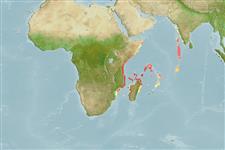Actinopterygii (ray-finned fishes) >
Perciformes (Perch-likes) >
Gobiidae (Gobies) > Gobiinae
Etymology: Trimma: Greek, trimma, -atos = something crushed (Ref. 45335); volcana: Named for Volcanus, Roman god of fire, referring to the amber-red spots on an earthy brown background that resemble numerous small, volcanic vents on a lava field, and is suggestive of the hot-spot origins of the Comores Islands; noun in apposition.. More on author: Winterbottom.
Environment / Climate / Range
Ecology
Marine; demersal; depth range 0 - 24 m (Ref. 57687). Tropical, preferred ?
Western Indian Ocean: Tanzania, Mozambique and the Comores Islands.
Size / Weight / Age
Maturity: Lm ? range ? - ? cm
Max length : 1.9 cm SL male/unsexed; (Ref. 57687); 1.7 cm SL (female)
Dorsal
spines
(total): 7;
Dorsal
soft rays
(total): 10-11;
Anal
spines: 9-11. Diagnosis: Characterized by having large spots on the head and body; moderate to well-developed interorbital and postorbital trenches; scales on the pectoral and pelvic fin bases, except on cheeks, opercles, or midline of the nape; a posterior nostril which is adnate to the eye; a fifth pelvic fin ray that is 80-9% of the fourth and is branched dichotomously twice (Ref. 57687).
Life cycle and mating behavior
Maturity | Reproduction | Spawning | Eggs | Fecundity | Larvae
Winterbottom, R., 2003. A new species of Trimma (Gobiidae) from the western Indian Ocean. Aqua, J. Ichthyol. Aquat. Biol. 7(1):9-12. (Ref. 57687)
IUCN Red List Status (Ref. 115185)
CITES (Ref. 94142)
Not Evaluated
Threat to humans
Harmless
Human uses
More information
Common namesSynonymsMetabolismPredatorsEcotoxicologyReproductionMaturitySpawningFecundityEggsEgg development
Age/SizeGrowthLength-weightLength-lengthLength-frequenciesMorphometricsMorphologyLarvaeLarval dynamicsRecruitmentAbundance
ReferencesAquacultureAquaculture profileStrainsGeneticsAllele frequenciesHeritabilityDiseasesProcessingMass conversion
Tools
Special reports
Download XML
Internet sources
